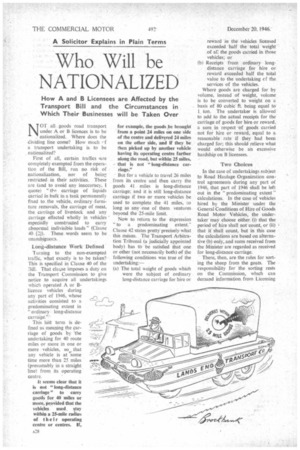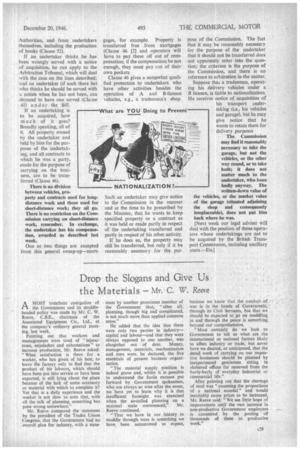A Solicitor Explains in Plain Terms
Page 30

Page 31

If you've noticed an error in this article please click here to report it so we can fix it.
Who Will be NATIONALIZED
How A and B Licensees are Affected by the Transport Bill and the Circumstances in Which Their Businesses will be Taken Over NOT all goods road transport under A or 13licences is to be nationalized. Where does the dividing line come? How much r t a transport undertaking is to be nationalized?
First of all, certain traffics cire completely exempted from the operation of the Bill, run no risk of nationalization, nor of beim:. restricted in their activities. These are (and to avoid any inaccuracy. I quote) " the carriage of liquids carried in bulk in a tank permanently fixed to the vehicle, ordinary furniture removals, the carriage of meat, the carriage of livestock and any carriage effected wholly in vehicles especially constructed to carry abnormal indivisible loads" (Clause 40 -[2]): These words seem to be unambiguous.
LOtii:,-disbance Work Defined Turning to the non-exempted traffic, what exactly is to be taken? This is specified in Clause 40 of the Ill. That clause imposes a duty on the Transport Commission to give notice to acquire all undertakings which operated A or Blicence vehicles during any part of 1946, whose activities consisted to a predominating extent in "ordinary-long-distance carriage."'
This LSI term is defined as as meaning the carriage of goods by 'the undertaking for 40 route miles or more in one or more vehicles, so. that any vehicle is at some time more than 25 miles (presumably in a straight line) from its operating centre.
It seems clear that it is not "long-distance carriage" to carry goods for 40 miles or more, provided that the vehicles used , stay within a 25-mile radius of their operating centre or centres. If,
for example, the goods be brought from a point 24 miles on one side of the centre and delivered 24 miles on the other side, and if they be then picked up by another vehicle having its operating centre farther along the road, but within 25 miles. that is not "long-distance carriage."
But for a vehicle to travel 26 miles from its centre and then carry the goods 41 miles is long-distance carriage; and it is still long-distance carriage if two or more vehicles be used to complete the 41 miles, Ea long as any one of them ventures beyond the 25-mile limit.
Now to return to the expression "to a predominating extent.Clause 42 states pretty precisely what this means. The Transport Arbitration Tribunal (a judicially appointed body) has to be satisfied that one or other (not necessarily both) of the following conditions was true of the undertaking:—
(a) The total weight of goods which were the subject of ordinary long-distance carriage for hire or reward in the vehicles licensed exceeded half the total weight of al: the goods carried in those vehicles; or (b) Receipts from ordinary longdistance carriage for hire or reward exceeded half the total value to the undertaking cf the services of the vehicles.
Where goods are charged for by volume, instead of weight, volume is to be converted to weight on a basis of 80 cubic ft. being equal to I ton. The undertaker is allowed to add to the actual receipts for the carriage of goods for hire or reward, a sum in respect of goods carried not for hire or reward, equal to a reasonable rate if they had been charged for; this should relieve what would otherwise be an excessive hardship on B licensees.
Two Choices
in the case of undertakings subject to Road Haulage Organization control agreements during any part of 1946, that part of 1946 shall be left out in the "predominating extent " calculations. In the case of vehicles hired by the Minister under the General Conditions of Hire of Goods Road Motor Vehicles, the undertaker may choose either (i) that the period of hire shall not count, or (ii) that it shall count, but in this case the calculations are based on alternative (b) only, and sums received from the Minister are regarded as received for long-distance carriage.
There, then, are the rules for sorting the sheep from the goats. The responsibility for the sorting rests on the Commission, which can demand information from Licensing Authorities, and from undertakers themselves, including the production of books (Clause 52).
If an undertaker thinks he has been wrongly served with a notice of acquisition, he can apply to the Arbitration Tribunal, which will deal with the case on the lines described; and an undertaker (if such there be) who thinks he should be served with a notice when he has not been, can demand to have one served (Clause 41) under the Bill.
If an undertaking is to be acquired, how much of it goes? Broadly speaking, all of it. All property owned by the undertaker and herd by him for the purposes of the undertaking, and all contracts to which he was a party, made for the purpose of carrying on the business, are to be transferred (Clause 46).
There is no division between vehicles, pro
perty and contracts used for longdistance work and those used for short-distance work; they all go. There is no restriction on the Commission carrying on short-distance work, remember. In exchange, the undertaker has his compensation, awarded as described last week.
One or two things are excepted from this general sweep-up—mort gages, for example. Property is transferred free from mortgages (Clause 46 [2] and operators will have to pay these off out of compensation; if the compensation be not enough, they must pay cut of their own pockets Clause 46 gives a somewhat qualified protection to undertakers who have other activities besides the operation of A. and B-licence vehicles, e.g. a tradesman's shop Such an _undertaker may give notice to the Commission in the manner and at the time to be prescribed by the Minister, that he wants to. keep specified property or a contract as it was held or made partly in respect of the undertaking transferred and partly in respect of his other activity.
If he does so, the property may still be transferred, but only if it be reasonably necessary for the pur. pose of the Commission. The fact that it may be reasonably necessary for the purpose of the undertaker that it should not be transferred does not apparently enter into the question; the criterion is the purpose of the Commission, and there is no reference to arbitration in• the matter.
Suppose thac a tradesman, operating his delivery vehicles under a B licence, is liable to nationalization. He receives notice of acquisition of his transport undertaking (i.e., his vehicles and garage), but he may give notice that he wants to retain them for delivery purposes
The Commission may find it reasonably necessary to take the garage, but not the vehicles, or the other way round, or to take both; it does not matter much to the undertaker, who loses badly anyway. The written-down value of the vehicles, or the market value of the garage (situated adjoining the shop and consequently irreplaceable), does not put him back where he was.
[Next week our legal adviser will deal with the position of those operators whose undertakings are not to be acquired by the British Transport Commission, including ancillary users.—Err.]




































































